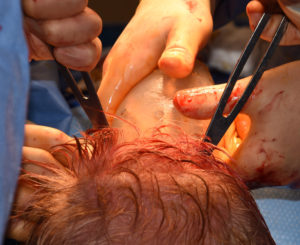A custom made implant is the best method to correct aesthetic contour deformities of the skull. It can be made in any shape and size provided there is enough scalp stretch to be able to close over it. Despite these implant benefits, unlike reconstructive skull surgeries, there is a much greater importance on limiting the length of the incision to do the surgery. This is of particular relevance given that almost 70% of aesthetic skull surgeries are done in men who often have limited or no hair cover. It is of no less significance, however, even in female patients that have good hair cover.
Limiting the length of scalp incisions using custom skull implants is based on their ability to be introduced through them. This optimally requires that they be deformable, much like a breast implant, so they can be reduced in size for insertion through the incision and then expanded back to its desired size and shape once inside the created subperiosteal scalp pocket.
This deformability requirement is why skull implants made out of solid silicone are so desirable. While they may be flexible/bendable when held in space, they become and feel as solid as bone when placed on the skull. The method of deformability of solid silicone skull implants for insertion is to roll it into a tubular shape. How successfully this is accomplished depends on the amount of central thickness that it has. Once this exceeds 10mms or more the ability to make a tight roll of the implant becomes more difficult.

These inner wedges or grooves also created a secondary benefit as well. As the scar tissue/capsule grows up into them this creates another source of implant fixation and migration prevention as well.
Dr. Barry Eppley
Indianapolis, Indiana



